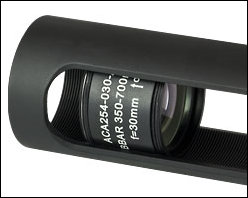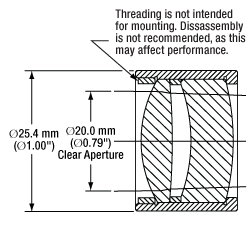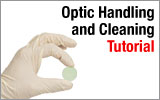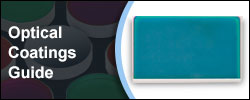Visible Air-Spaced Achromatic Doublets, AR Coated: 350 - 700 nm

- Minimal Focal Shift Over the Design Wavelength Range
- Superior Performance When Compared to Cemented Doublets
- 1" Outer Diameter Aluminum Housing
ACA254-200-A
ACA254-030-A
Each mount includes an engraved arrow
indicating the direction of light propagation
required to collimate a point source.

Please Wait
| General Specifications | |
|---|---|
| Coating Rangea | 350 - 700 nm |
| Design Wavelengths | 486.1, 587.6, 656.3 nm |
| Surface Quality | 20-10 Scratch-Dig (to Prevent Scattering from High-Power Sources) |
| Clear Aperture | Ø20 mm |
| Irregularity per Surface | <λ/4 at 633 nm |
| Focal Length Tolerance | ±1% at 587.6 nm |
| Reflectance | Ravg < 0.5% (350-700 nm) |
| Housing | Ø1" 6061-T6 Aluminum Barrel |

Click to Enlarge
Air-Spaced Achromatic Doublet in an SM1L30C Slotted Lens Tube with Two SM1RR Retaining Rings
Features
- Air-Spaced Doublet Design Provides Superior Aberration Performance than Singlet Lenses
- Ø20 mm Clear Aperture
- 1" Outer Diameter for Mounting Inside a Ø1" Lens Tube
- AR Coating for the 350 - 700 nm Range
Thorlabs' Air-Spaced Achromatic Doublets are designed to provide superior spherical and chromatic aberration correction. Air-Spaced Doublets have two more degrees of freedom than cemented doublets because the interior lens surfaces do not need to have the same curvature. These extra variables allow the performance of these air-spaced doublets to exceed the performance of equivalent cemented doublets in some cases. For details, please see the Lens Comparison tab. The air-spaced design is also highly resistant to laser damage, since no cement is utilized in the fabrication process. Although these lenses have an AR coating for the 350 - 700 nm range deposited on both surfaces, the glass they are fabricated from displays limited or no transmission in the UV (<400 nm). Hence, please refer to the table below for exact specifications and transmission plots for each air-spaced doublet.
The doublets are pre-mounted in an aluminum barrel with tight tolerances on lens and barrel diameter to minimize the effects of lens decentering. Each mount includes an engraving with the part number, AR coating wavelength, focal length, and the direction of light propagation required to collimate a point source. The mount has a 1" outer diameter for mounting inside a Ø1" lens tube (as shown in the photo to the right).
Note: We do not recommend disassembly of these lenses, as this may affect performance.
| Air-Spaced Doublets Selection Guide | |
|---|---|
| UV (245 - 400 nm) | D (1.65 - 3 µm) |
| Visible (350 - 700 nm) | E (3 - 5 µm) |
| NIR (650 - 1050 nm) | E3 (7 - 12 µm) |
| Laser-Line (532 & 1064 nm) | |
The table below contains links to pop-ups with plots containing a comparison of the theoretical performance of an air-spaced achromatic doublet and a cemented achromatic doublet with the same focal length. Comparisons are made for the transmitted wavefront error and spot radius. Raw data from each graph below can be downloaded by clicking here.
| Plot Key | |
|---|---|
| Cemented Doublets | |
| Air-Spaced Doublets | |
| Diffraction Limit | |
| Airy Disk | |
| Posted Comments: | |
Takeharu Sekiguchi
(posted 2025-03-03 14:42:06.413) Regarding the achromatic doublets such as ACA254-030-A and ACA254-030-AB, "Spot Diameter Plots" on the "Lens Comparision" tab shows much larger diameter in comparison to the diffraction limit or Airy disk.
Does this mean the achromatic doublets are much larger in terms of the focused beam spot size than an aspheric lens or even a spheric convex lens, of the same focus length?
This spot diamter is calculated for a collimated input beam of 7 mm radius, right? How much for a smaller input diameter, e.g. 2 mm? user
(posted 2024-07-16 10:44:04.55) You cannot market a lens that is AR coated 350-700 as a 350-700 optic if the base material does not transmit 350. ksosnowski
(posted 2024-07-17 11:46:16.0) Thank you for sharing this feedback with us. While the AR coating design band extends to 350nm and is the same as our other -A coated optics, we mention on the page above that there is limited to no transmission in the range <400nm. There are also transmission plots on this page to view the typical performance of each doublet. The design wavelengths for these doublets are 486.1, 587.6, and 656.3 nm. We have some similar doublets like ACA254-100-UV with UV design wavelengths, a -UV AR coating and better internal transmission in UV. Christian Goerke
(posted 2023-03-28 16:47:27.99) I am missing a download option for the transmission data in the table. Can you provide one? ksosnowski
(posted 2023-05-01 03:37:33.0) Thanks for reaching out to Thorlabs. We have contacted you directly to share a data table format for these plots. user
(posted 2021-08-26 23:46:56.397) Missing axial color plot, I need for ACA254-200-A cdolbashian
(posted 2021-08-31 03:47:34.0) Thank you for contacting us here at Thorlabs. I have contacted you directly with this data. ludoangot
(posted 2016-01-29 14:47:39.4) From the plots comparing the cemented and air-spaced doublets it appears that for f=150 and 200mm, there is no clear advantage (from an optical performance perspective) to using an air-spaced doublet over a cemented one. Is there any advantage for these 2 focal lengths in using an air-spaced doublet over a cemented one for imaging application? besembeson
(posted 2016-02-03 04:41:27.0) Response from Bweh at Thorlabs USA: For general imaging applications, performance will be very similar for these two doublets. However, if you have a high power level application, the air-spaced doublets will be better suitable. scottie730318
(posted 2014-04-30 16:51:32.23) The transmission Plot of ACA254-100-A shows that
high transmission cover the wavelength from 300 nm to 700 nm. Can the transmittance at wavelength between 300 nm t0 350 nm be believed? jlow
(posted 2014-05-01 08:44:01.0) Response from Jeremy at Thorlabs: It seems that we made a mistake on these graphs. We will be updating the transmission curves on this page shortly. Thanks for bringing this to our attention. user
(posted 2013-10-01 09:39:19.1) Could you check the spot radius plots? The plots seem to show larger spot sizes at shorter focal lengths, with sub micron spot sizes available from 150mm and 200mm focal length lenses. tcohen
(posted 2013-10-01 21:06:00.0) Response from Tim at Thorlabs: These plots were calculated to show the quality of the design using RMS spot radius with respect to the centroid. The performance of the actual lenses will still be limited by diffraction. Some lenses that are theoretically borderline on the diffraction limit can end up being not diffraction limited depending on manufacturing tolerancing. Plotting the theoretical values such as this allow us to see the design and the margin below the diffraction limit. Although the diffraction limit will increase with increasing focal length and with decreasing beam diameters, these lenses will typically have theoretical rms spot sizes that decrease with increasing focal lengths and decreasing beam diameters. In terms of the RMS spot size shown in these plots, yes, we should expect to see smaller spot sizes for longer focal length lenses. However, I believe you were noting the point that if they are diffraction limited, in reality the actual diffraction limited spot size will be larger for longer focal lengths, which is correct. We are discussing how to make these plots more understandable. Thanks for your feedback! curtis.volin
(posted 2013-02-20 13:02:50.053) Can you publish zmx files for these lenses? The ZAR files published for some of them are useless in other versions of zemax than were used to create them.
My attempts to create my own ZMX files from the data in the table are failing. The specs for ACA254-050-A give a lens with 30mm EFL. I could assume the table is shifted and this is the prescription for ACA254-030-A, but I don't trust the glass table, either. tcohen
(posted 2013-02-21 14:58:00.0) Response from Tim at Thorlabs: Thank you for your feedback! You are correct. There was a clerical error in the table and we are updating this right now. Supplying both .zar and .zmx is an active project. In the meantime, we can supply these files on request to techsupport@thorlabs.com. I will contact you directly to provide the .zmx versions. tcohen
(posted 2012-11-13 10:23:00.0) Response from Tim at Thorlabs: Thank you for contacting us. We will update our presentation with these files. In the meantime, I will send you them directly. dbarker2
(posted 2012-11-09 14:49:54.147) Is it possible to get Zemax files for the -A coated doublets? sharrell
(posted 2012-08-01 12:12:00.0) Response from Sean at Thorlabs: Thank you for your feedback. You are correct that the focal shift units should be mm. We are in the process of updating those graphs. The link that is present in your feedback is for our -A coated achromats, while these air-spaced doublets feature our -B (650-1050 nm) coating. There is a curve for our -B cemented doublets here: http://thorlabs.com/NewGroupPage9.cfm?ObjectGroup_ID=259 that agrees with the curve on this page. If you are interested in air-spaced doublets with our -A coating (400-700 nm), we will be adding these lenses to our product line within the next two months. user
(posted 2012-08-01 10:35:58.0) The focal shift data presented here seems inconsistent with the data published elsewhere (http://thorlabs.com/NewGroupPage9.cfm?ObjectGroup_ID=120). Should the focal shift units be mm? Besides the units, there also appears to be a discrepancy in the values. |

a. Left Lens Center Thickness in the Reference Drawing b. Right Lens Center Thickness in the Reference Drawing c. Center Air Spacing Between the Lenses.
 Products Home
Products Home












 Air-Spaced Achromatic Doublets(VIS AR Coating)
Air-Spaced Achromatic Doublets(VIS AR Coating)